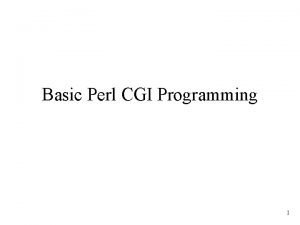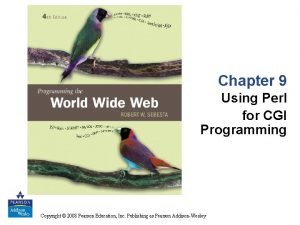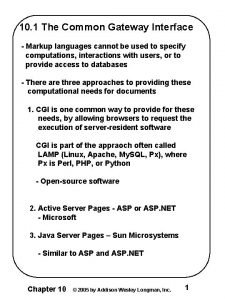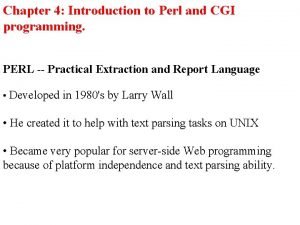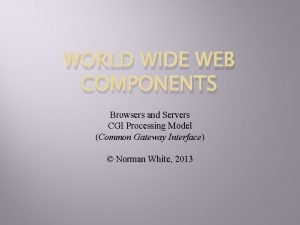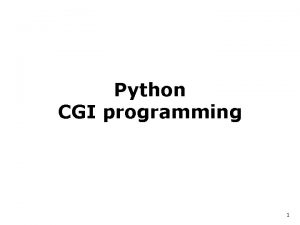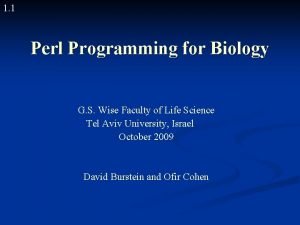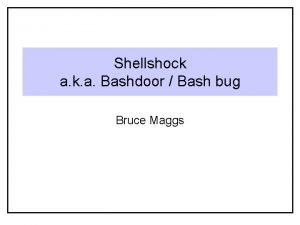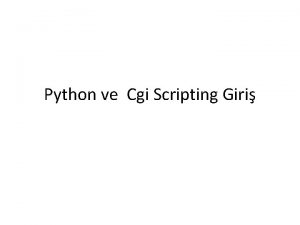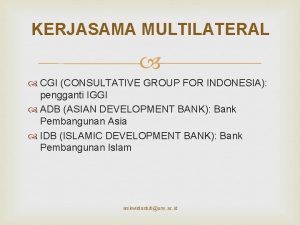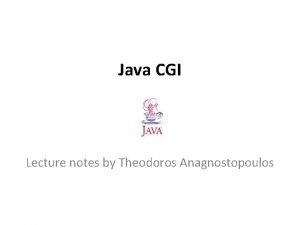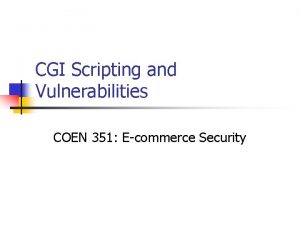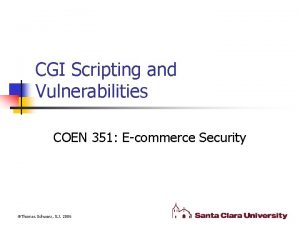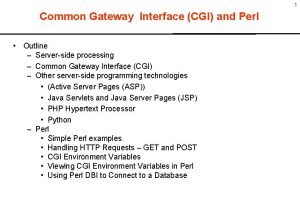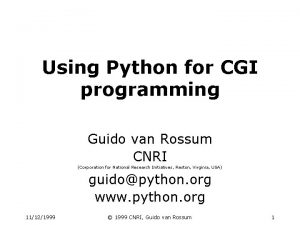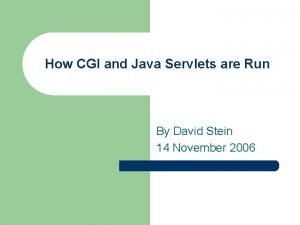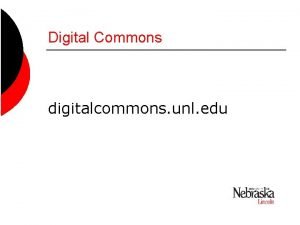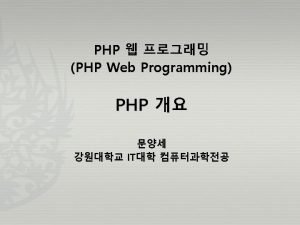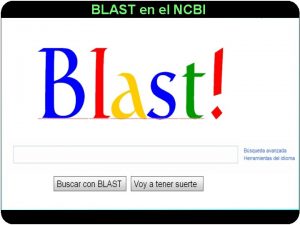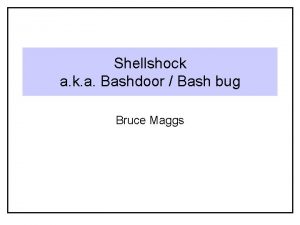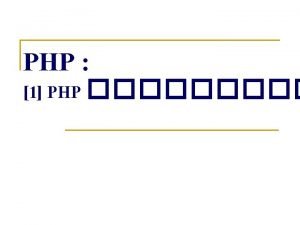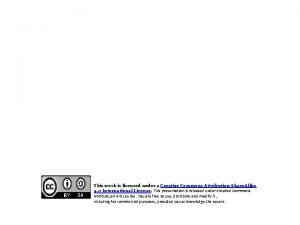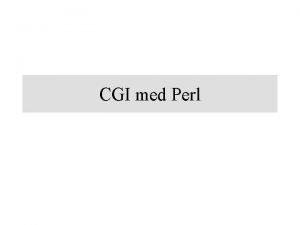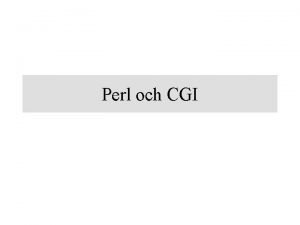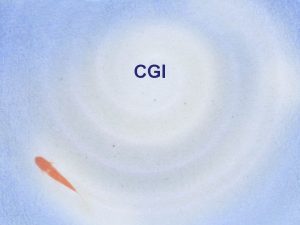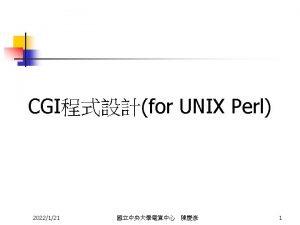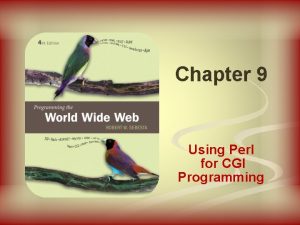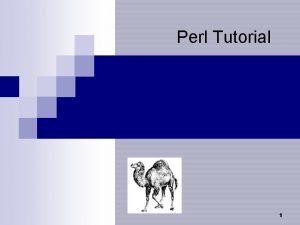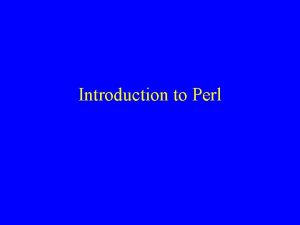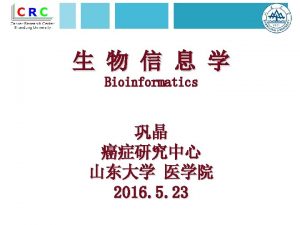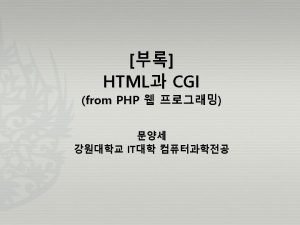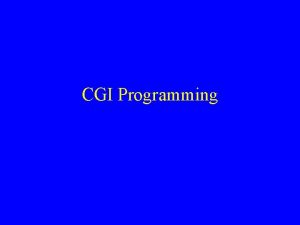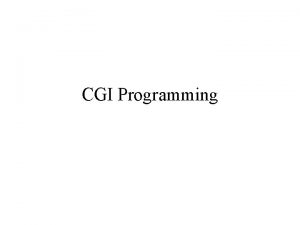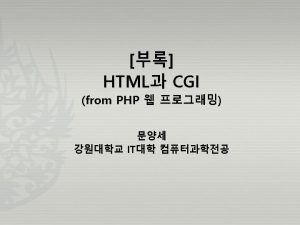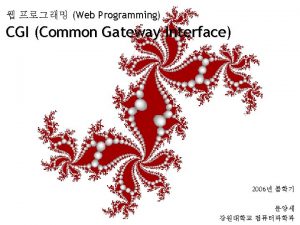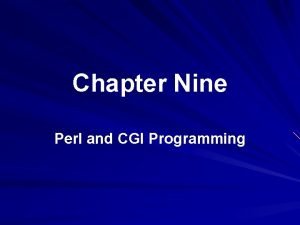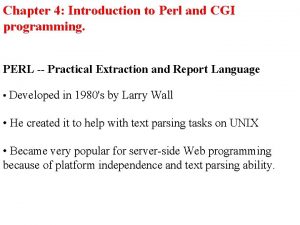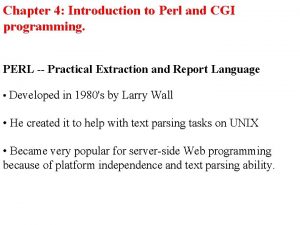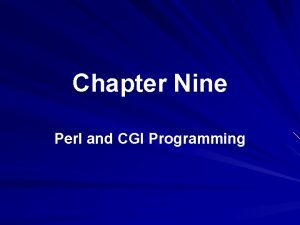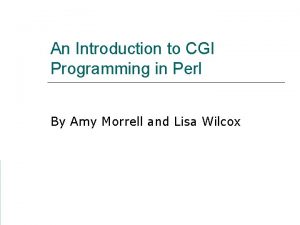Chapter 9 Using Perl for CGI Programming Copyright


























- Slides: 26

Chapter 9 Using Perl for CGI Programming Copyright © 2008 Pearson Education, Inc. Publishing as Pearson Addison-Wesley

9. 1 The Common Gateway Interface • Computation is required to support sophisticated web applications • Computation can be done by the server or the client (browser) or both • The Common Gateway Interface (CGI) is a protocol describing a standard way of providing server-side active web content • Under circumstances determined by the server, an HTTP request will cause a program to run • The output from the program will be the response returned to the client making the request • Data from forms will be encoded in a request sent do the server • This data can be used by a CGI program Copyright © 2008 Pearson Education, Inc. Publishing as Pearson Addison-Wesley 9 -2

9. 1 Other Approaches • ASP. NET from Microsoft • Executable code embedded in web pages • Java Servlets and Java Server Pages • Servlets are executable code in Java • Java server pages (JSP) are executable code embedded in web pages Copyright © 2008 Pearson Education, Inc. Publishing as Pearson Addison-Wesley 9 -3

9. 2 CGI Linkage • There are several common ways a web server can use to determine if a web request should cause a CGI program to execute • Usually, the determination is based on the target of the request • Certain directories can be designated as containing CGI programs • Often cgi-bin is used • Certain file extensions can be designated as signifying a CGI program • . pl usually identifies a Perl script • AT RU: Perl programs must be put in the cgi-bin directory and a cgiwrap syntax is used for their URL The cgi-bin directory should be created inside (below) the public_html directory in your RU account. /jcdavis/public_html/cgi-bin/firstperl. pl Copyright © 2008 Pearson Education, Inc. Publishing as Pearson Addison-Wesley 9 -4

9. 2 CGI Linkage • A request for a CGI program to executed can be made with a simple link (<a> tag in HTML) • This method is limited • Any data sent must be hard-coded into the link • At RU: The URL to use to call a perl program using an anchor tag in an html document would be: <a href="http: //www. radford. edu/ cgi-bin/cgiwrap? user=jcdavis &script=reply. pl"> Click here to run reply. pl</a> • The usual way for invoking CGI programs is through the action attribute of a form • Data from the form is then encoded and sent with the request Copyright © 2008 Pearson Education, Inc. Publishing as Pearson Addison-Wesley 9 -5

9. 2 CGI Program Action • The CGI program generally creates the response by sending output to the standard output stream • Using print in Perl • The CGI program will usually have to provide the content-type header • Content-type: text/html • This will be the last line of the response headers and must be followed by a blank line • The rest of the response is created by printing the HTML code desired to standard output Copyright © 2008 Pearson Education, Inc. Publishing as Pearson Addison-Wesley 9 -6

Print HTML Doc. #!/usr/local/gnu/bin/perl -# reply. pl – a CGI program that # returns a greeting to the user print "Content-type: text/html nn", "<html> <head> n", "<title> reply. pl example </title>", " </head> n", "<body> n", "<h 1> Greetings from your Web server!", " </h 1> n </body> </html> n"; • reply. html reply. pl Copyright © 2008 Pearson Education, Inc. Publishing as Pearson Addison-Wesley 9 -7

9. 3 Query String Format • Both GET and POST requests under HTTP can be used to carry form data from the browser to the server • The data is formatted into a query string • Each form of request includes the information in a different way • In a GET request, the query string is appended to the URL of the request, with a question mark used to separate it from the first part of the URL • In a POST request, the query string is sent as the data part of the request • In both cases, the query string is formatted the same Copyright © 2008 Pearson Education, Inc. Publishing as Pearson Addison-Wesley 9 -8

9. 3 Query String Format • Each unit of data sent is encoded as name = value • The name is usually the value of a name attribute of a form widget • The value is the string representation of the widget value • Several units are combined by separating them with ampersands, & • Special characters in name and value are encoded • The code is a percent sign, %, followed by the hexadecimal code for the character • A space is encoded as %20 • Some browsers will encode spaces as + Copyright © 2008 Pearson Education, Inc. Publishing as Pearson Addison-Wesley 9 -9

9. 3 Query String Access • When the POST method is used, the query string can be read from standard input • The CONTENT_LENGTH environment variable tells how many characters can be read • When The GET method is used, the query string is given by the value of the environment variable QUERY_STRING Copyright © 2008 Pearson Education, Inc. Publishing as Pearson Addison-Wesley 9 -10

9. 4 The CGI. pm Module • Writing a CGI program from scratch is very tedious • Creating HTML requires numerous print statements • Retrieving data from the query strings is tricky • One of the reasons for Perl’s popularity for CGI programming is the powerful pattern matching facilities which greatly ease the task of parsing a query string • The Perl module CGI. pm provides numerous functions to help with both of these problems Copyright © 2008 Pearson Education, Inc. Publishing as Pearson Addison-Wesley 9 -11

9. 4 Shortcut Functions in CGI. pm • Shortcut functions return string values containing HTML code • Note, the string must be printed out to actually become part of the response • Some functions take no arguments print br; puts the tag <br/> into the response • Some functions can be given a single argument which becomes the content of the tag print h 1(“A Header”) puts <h 1>A Header</h 1> into the response Copyright © 2008 Pearson Education, Inc. Publishing as Pearson Addison-Wesley 9 -12

9. 4 Tag Attributes in Shortcut Functions • Attributes for tags are provided as attribute/value pairs in the argument list of the shortcut function • The arguments are provided in the form of a literal hash • Attribute names are preceded by a hyphen, - print textarea(-name => "Description", -rows => "2", -cols => "35"); produces this in the response <textarea name="Description" rows="2" cols="35"> </textarea> Copyright © 2008 Pearson Education, Inc. Publishing as Pearson Addison-Wesley 9 -13

9. 4 Attributes and Content • Attributes and content can both be provided to a shortcut by giving the attributes explicitly as a hash reference print a({-href => "fruit. html"}, Press here for fruit descriptions"); produces this in the response <a href="fruit. html"> Press here for fruit descriptions </a> • If an array reference is provided for the content, a tag is created for each item, giving the tag all the specified attributes Copyright © 2008 Pearson Education, Inc. Publishing as Pearson Addison-Wesley 9 -14

9. 4 More Shortcuts • The head shortcut function provides a standard header • The start_html function provides the beginning part of an HTML document, through the <body> start tag • The function takes one argument, the document title Copyright © 2008 Pearson Education, Inc. Publishing as Pearson Addison-Wesley 9 -15

9. 4 Accessing Form Data • The param function takes a name as an argument • The function returns the value associated to the name, if any, in the request Copyright © 2008 Pearson Education, Inc. Publishing as Pearson Addison-Wesley 9 -16

9. 4 A Complete Form Example • The example includes an HTML page, popcorn. html, for placing an order • At RU: method=“post” • Also it includes a Perl CGI program for processing the data, popcorn. pl • Note, to run this example, you must have a web server configured to run CGI programs, you cannot simply browse to the file on your local system Copyright © 2008 Pearson Education, Inc. Publishing as Pearson Addison-Wesley 9 -17

9. 5 A Survey Example • The survey example is keeps track of data from a simple survey • There are three components • conelec. html presents the form and links • conelec 1. pl processes a survey • conelec 2. pl presents a summary of the results Copyright © 2008 Pearson Education, Inc. Publishing as Pearson Addison-Wesley 9 -18

9. 5 Saving the Data • A file is used to store a summary of the data • The file is updated by conelec 1. pl after each survey is submitted • Care must be taken that two simultaneous requests do not interfere with each other • Both CGI programs will use the Perl flock function that will allow only one program at a time access to the file • The file is accessed by coneclec 2. pl for each request for a summary Copyright © 2008 Pearson Education, Inc. Publishing as Pearson Addison-Wesley 9 -19

9. 5 Table Shortcut Functions • The Tr function will create a sequence of table rows from an argument that is a reference to a list • Tr is capitalized to distinguish it from the transliterate function tr • Similarly, the th and td functions will produce a sequence of tags from a reference to a list Copyright © 2008 Pearson Education, Inc. Publishing as Pearson Addison-Wesley 9 -20

9. 5 Table Example table({-border => "border"}, caption("Sales Figures"), Tr( [th(["Salesperson", "Mon", "Tues", “Wed", "Thu", "Fri"]), th("Mary"). td(@marysales), th("Freddie"). td(@freddiesales), th("Spot"). td(@spotsales), ] ) ); • Note the period between the th and td function calls, this concatenates the results in order to make a single row Copyright © 2008 Pearson Education, Inc. Publishing as Pearson Addison-Wesley 9 -21

9. 5 Table Example Results Copyright © 2008 Pearson Education, Inc. Publishing as Pearson Addison-Wesley 9 -22

9. 6 Cookies • HTTP is a stateless protocol, that is, the server treats each request as completely separate from any other • This, however, makes some applications difficult • A shopping cart is an object that must be maintained across numerous requests and responses • The mechanism of cookies can be used to help maintain state by storing some information on the browser system • A cookie is a key/value pair that is keyed to the domain of the server • This key/value pair is sent along with any request made by the browser of the same server • A cookie has a lifetime which specifies a time at which the cookie is deleted from the browser Copyright © 2008 Pearson Education, Inc. Publishing as Pearson Addison-Wesley 9 -23

9. 6 Cookies and Security • Cookies are only returned to the server that created them • Cookies can be used to determine usage patterns that might not otherwise be ascertained by a server • Browsers generally allow users to limit how cookies are used • Browsers usually allow users to remove all cookies currently stored by the browser • Systems that depend on cookies will fail if the browser refuses to store them Copyright © 2008 Pearson Education, Inc. Publishing as Pearson Addison-Wesley 9 -24

9. 6 Cookie Functions • The cookie function takes a hash with three keys for the name, value and expiration time of a cookie • The cookie value produced by this function must be passed to the header function using the –cookie key header(-cookie => $a_cookie) • Calling the cookie function with no arguments produces a hash of all cookies from the current request • The day_cookie. pl example illustrates using a cookie to store the last time the page was visited day_cookie. pl code Copyright © 2008 Pearson Education, Inc. Publishing as Pearson Addison-Wesley 9 -25

Perl Errors • It can be difficult to debug perl programs, because error messages are not returned to the browser • You can include the following to see the error messages. • simpleinput. html simpleerror. pl Copyright © 2008 Pearson Education, Inc. Publishing as Pearson Addison-Wesley 9 -26
 Perl cgi programming
Perl cgi programming Cgi linkage in perl
Cgi linkage in perl Cgi linkage in perl
Cgi linkage in perl Cgi perl
Cgi perl Cgi programming on the world wide web
Cgi programming on the world wide web Cgi programming in python
Cgi programming in python Chromosome example in real life
Chromosome example in real life Printenv.pl exploit
Printenv.pl exploit Python cgi
Python cgi Analisislah manfaat cgi bagi indonesia
Analisislah manfaat cgi bagi indonesia Theodoros anagnostopoulos
Theodoros anagnostopoulos Common global implementation
Common global implementation Cgi ecommerce
Cgi ecommerce Cgi ecommerce
Cgi ecommerce Common gateway interface (cgi) application
Common gateway interface (cgi) application Nodejs cgi
Nodejs cgi Python cgi tutorial
Python cgi tutorial Cgi in java
Cgi in java Madeleine jacobs
Madeleine jacobs Apmsetup7
Apmsetup7 Ncbiblast
Ncbiblast Printenv.pl exploit
Printenv.pl exploit Cgi language
Cgi language Cgi
Cgi Cgi
Cgi Chang cgi
Chang cgi Perl tutorial javatpoint
Perl tutorial javatpoint
